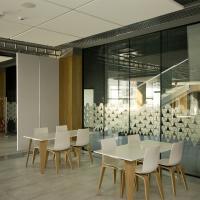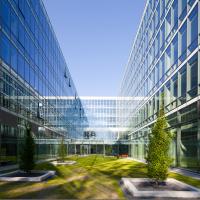Date: 11 January 2010
Denis Wright, the company’s managing director, says that that steel glazing systems, once confined to commercial applications, are now being specified in the residential sector.It is without doubt our greatest resource and, without it, life on earth could not exist. It is more than one of life’s building blocks: it is the foundation stone on which all life depends. Yet, strangely, even architects can take it for granted.It arrives here about eight minutes after being generated by the hugely inefficient atomic power station that is our sun. Every second it converts a whopping 657 million tons of hydrogen into an equally whopping 653 tons of helium – although only a paltry four tons is discharged into space as light and energy.Underlining its inefficiency, the earth receives only one two-billionth of the sun’s total energy output.But light is fundamental to our existence, possessing absolute form and total function. It has the power to grow our crops, give us vision and influence how we feel.However, even in commercial applications, the primary importance of light is often undervalued. Put simply, good buildings need light to function and, in particular, natural light to function properly.In any building context, light should be seen as a building product of similar importance to bricks and mortar. It’s not just about functionality or the ambience that light can generate; it’s about providing connectivity between the outside and the inside.We are all adversely affected by bad buildings that make poor use of light. Indeed, recent studies suggest that a major cause of UK work-related absenteeism is caused, directly or indirectly, by poor lighting. At best, it can be demotivating; at worst, debilitating. It’s estimated that, of all those who are off sick from work, about a quarter of those absences will be building-related.However, the detrimental effects of light can be just as pronounced in our homes, because lack of light alters our circadian rhythm – the fundamental sleep/wake pattern controlled by the brain chemical melatonin. In extreme cases, this is a direct cause of depression and conditions such as seasonal affective disorder (SAD).In comparison, good building design that lets light flood in, bringing the outside world into our homes, can have the opposite effect. With modern glazing technology, it also blurs the dividing line between the outside and inside, giving our homes a fundamental sense of space and place within their surroundings.Only light has the power to offer that transformation, and only glass and glazing can make it happen. However, advanced glazing technologies are relatively new to the residential sector and architects have yet to universally recognise the potential that new glazing systems can achieve, using light as the bridge between our homes and what lies beyond.Until recently, glazing technology could only offer limited spans of glass because the framing systems used in residential applications were made from timber, aluminium or UPVC and therefore lacked tensile strength. That’s not to disparage other glazing systems; merely to emphasise that, when it comes to size, all have practical framing and wind-load limitations.The lesson is that, if size matters, it has to be steel – a framing system that has quietly moved from the commercial sector to make visually exciting inroads into residential housing.We are now seeing a quiet revolution in residential glazing, with creative designers making use of internal and external space and designing a new dynamic between the two. In some cases, where large glass spans have been utilised, the dividing line between inner and outer space has effectively been removed.In a room without walls, the effect can be aesthetically stunning. For the architect, it represents a new freedom to design homes in radically new styles, making use of new technologies to offer their clients a unique and better living experience.Only steel can realistically achieve this because of the medium’s superior strength. Once confined to large span curtain walling on commercial buildings, a high-performing steel system can cost-effectively make possible what was hitherto impossible in a residential context.A stunning example is in New Zealand, where we supplied sixteen steel glazed and openable door leaves for a home in Queenstown. The house itself looks out on the Remarkable ski field to one side and, on another, to the Coronet Peak ski slopes – both vistas of immense natural beauty.Rather than create a barrier between the home’s inner space and the beautiful views outside, the enormous sliding doors and large spans of glass entirely remove the boundary lines between internal and external spaces, placing the home and its occupants within the countryside outside. Other architects are following suit, and not just in New Zealand.The unrivalled strength of steel glazing not only gives architects greater freedom to design uniquely wonderful buildings, but to integrate any colour scheme into the framing system. These methods include air-dry, multi-coat or thermo hardened powder coating and can be matched to any colour requirement. This ensures that our systems are as visually appealing as powder coated aluminium.All that said, there is no specific glass size at which aluminium must give way to steel. There are a variety of deciding factors, with the most important being glass dimensions – for example, overall size, thickness, classification and application – plus other requirements such as wind loading. In a specific location, aluminium might be okay, in another, not okay.A steel glazing system isn’t a simple commodity and its suitability for a particular application depends on the required end performance, all backed by a rigorous testing programme that will deliver on those performance targets. Put simply, as size and performance requirements increase, the balance tips inexorably towards steel.It all comes down to light and how today’s designers can utilise that greatest of all natural resources. With a steel glazing system, size is no longer a constraint; rather, utilising light itself as a building medium, size can liberate the design process and produce homes that are a unique and integral part of their natural surroundings.From the Land of the Long White Cloud to a building site near you…a new age of design transparency might just be beginning.
Ends
For further technical information, please contact
Denis Wright, Jane Embury or Lee Coates
+44 (0) 1380 722 239
For further media information, please contact
Charlie Laidlaw, David Gray PR
+44 (0) 1620 844736 or (mobile) +44 (0) 7890 396518


















Add new comment